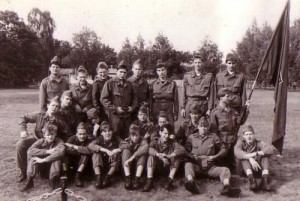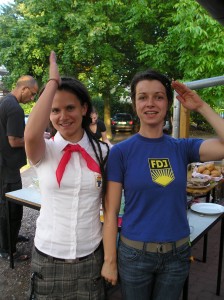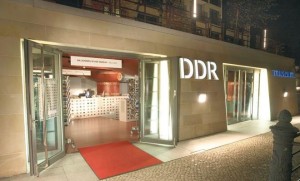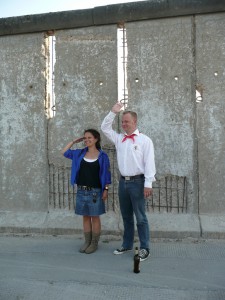 In spring 2008 Sylvie’s brother visited us together with his girlfriend in Berlin. These two are very pleasant visitors. We don’t have to entertain them at all. No cultural programme to arrange, no endless thinking which historic sites of the capital they don’t know yet. We didn’t even have to buy the current city magazines to search for the latest musicals, movies or theatre plays. Andi and Kati are interested in… nothing. Very pleasant, as I said! They both were born in the south west of Germany, in the so called Pfalz, like my Sylvie. This is obviously one reason why they often pelt me with questions about my East German youth for hours. Thus, I wanted them to soak up some education about this time by sending them into the GDR museum opposite the Berlin Cathedral and the ruin of the Palace of the Republic.
In spring 2008 Sylvie’s brother visited us together with his girlfriend in Berlin. These two are very pleasant visitors. We don’t have to entertain them at all. No cultural programme to arrange, no endless thinking which historic sites of the capital they don’t know yet. We didn’t even have to buy the current city magazines to search for the latest musicals, movies or theatre plays. Andi and Kati are interested in… nothing. Very pleasant, as I said! They both were born in the south west of Germany, in the so called Pfalz, like my Sylvie. This is obviously one reason why they often pelt me with questions about my East German youth for hours. Thus, I wanted them to soak up some education about this time by sending them into the GDR museum opposite the Berlin Cathedral and the ruin of the Palace of the Republic.
In the evening Andi and Kati already awaited me excitingly at the door smiling from one ear to the other. They had seen the Mufuti (multifunctional table) from the movie “Sonnenallee”, next to a real East German wall unit. Andi had sat in a Trabi for the first time in his life and Kati was taught how to tie a knot into the red triangular scarf of the children’s organisation in the GDR (Junge Pioniere). I was completely knackered from a hard capitalistic working day and thought that this museum visit had answered all their questions about my ex-country. Far from it! Now they wanted to know everything about the GDR, their curiosity was doubled or even tripled, and everything about this vanished country was most ingenious. I went to take a green booklet and a beer and told them a totally different story.
During the GDR-season of 1985 / 86 there were these two highlights of my life: At the beginning of the year 1985 we were affiliated solemnly to the Free German Youth and in March 1986 Jugendweihe took place – the ceremony in which teenagers are given adult social status – the biggest event of my life so far receiving a lot of presents. Between these two events, however, we had to prove our maturing process by attending a ten-hours-course of the Free German Youth. Naturally this was linked to a threat saying if one of us is absent two times and has no convincing excuse, he or she won’t take part in this mega party Jugendweihe. One after the other had to write something about this course into the youth lesson’s booklet. Probably this is the reason why I still keep this green booklet in my possession. I had to write about the last event and never handed it back.
I read out of this green booklet to the West German audience who gained another valuable insight into the country I had grown up.
The first lesson was called “We fulfil our revolutionary bequest!” Most of the 8th graders fulfilled this by visiting the concentration camp Sachsenhausen. Sabine wrote the following about this trip into the green youth lesson’s booklet: “On 18th September 1985 our class visited the concentration camp memorial Sachsenhausen. Mrs Rittich, Mrs Demant and Mrs Seil accompanied us. Arriving there we were welcomed by our guide Mr Stenzel who had been detainee himself in this concentration camp.”

I stopped here although Sabine had written exactly one page about this trip as she and all the others were supposed to do. We misbehaved completely at this trip. Nobody had really taught us that there were people having emotions and real victims to touch from this Hitlerite fascism. In our socialist daily routine we only vowed that we would do everything to avoid a repetition of these atrocities. We were not prepared for food rations of 150 grammes per day and heaps of corpses. Kati said that she was also sent to the concentration camp Ravensbrück when she was quite young and she grew up in West Germany. And suddenly we were discussing poor educational policy in East and West Germany, though I only wanted to tell them something about my life in the GDR. After a while I turned the pages and decided to read out only one sentence from every youth lesson in the green booklet.
The second youth lesson was named: “Friendship to Lenin’s country – matter of the heart of our people”. Naturally we visited the House of the German-Soviet Friendship (DSF). In sixth grade we always made our Russian teacher who came from Moscow cry with the following slogan: “Russki, Russki you should know that your language is just too slow!” In the DSF house we didn’t dare to talk like that and therefore were bored to death. However, Daniela wrote into the green booklet: “Comrade Steyer taught us a lot about the Soviet Union, how the people live there, how the gas pipeline BAM was built – the Baikal-Amur-Magistrale – and many other interesting things.”
The third youth lesson which was called: “Culture and Art make our lives nicer and richer.” seemed to be slightly better. We were supposed to visit the Jahn sports park. Similar to the other ‘events’ we were disappointed bitterly once again. It is enough if I just repeat what Lars wrote into the green booklet. “Then we went to the exhibition rooms. An old man waited there for us. After we had put off our jackets we entered the sports exhibition in a small room.”
The guests from the West looked at me with big and pleading eyes, but I continued without any reaction.
The fourth youth lesson was titled ‘The other one beside you.’ Our class went to the newly built park named after the communist leader Ernst Thälmann. Somehow it was a little bit more interesting this time since a quite cool guy led us through the construction site and even the scaffolds. The massive monument of Ernst Thälmann nicknamed Teddy was erected only recently. Thus, Lydia remarked quite correctly: “This visit was very interesting and good fun. Despite our breaches of discipline we experienced many new things.”

The fifth youth lesson in this series was called ‘Our Socialist Homeland’ and we were supposed to visit the People’s Police museum. A popular children’s song says: “The people’s police officer, who means well for us, he carries us home, he is our friend.” But these friends there were all completely unsympathetic, had a Saxon accent and one could imagine that concerning crimes they wouldn’t react indulgently. The importance of our visit in the People’s Police museum you can hear in the following sentences that Didi wrote: “When we arrived, the speaker Colonel Schmidt introduced himself. Another comrade guided us through the exhibition.”
Number six was called: ‘Peace is not a present.’ This was the event when I didn’t take part having an excuse. No, I had never been an absentee at school, a normal East-Berlin flu had struck me down. The others went to see the East German border troops. Hence, I can only read what Mario wrote into the book: “At the entrance gate an officer of the border troops welcomed us. First, he showed us a radio and a field telephone. Then we had a look at some of the tools that were used while escaping and also at some pictures of the injured people who tried to trespass the East German border. He acquainted us with some weapons and explained the function and advantages to us.” Andi and Kati were shocked shaking their heads in disbelief.
I was fit again for the next topic: ‘Your right and your duty in a socialist country’. We went to the court in Berlin – Friedrichshain. But this visit was one to forget soon, too. A very strict looking judge was telling us in a one-hour-lasting monologue how a trial takes place. After that she responded to our questions for only two minutes and disappeared. Cake wrote in our book: “We were also surprised about this small courtroom, since they appear much bigger in the movies. It would have been even better, if we had taken part in a real trial.”
‘Scientific technological progress – a challenge for you’ was the topic of the 8th lesson. We went to the completely shabby, but nationally owned company NARVA that used to produce light bulbs. Now we could see what publically owned manufacturing meant: rusty old machines, long dark passages without any ventilation, and moody people standing in a crowd at the corner, smoking and chatting. Next to the lathes and on a stack of fluorescent tubes there were lots of empty brown beer bottles. We were welcomed by a comrade in the traditional room. Although NARVA light bulbs were delivered around the world, successful tradition surely looks totally different, thought Bergi obviously when he – surprisingly honest – wrote into the book: “The visit at NARVA was not nice at all. I’d describe it as a complete failure.”

The last but one youth lesson was dedicated to the topic ‘Your workforce is needed’.
The funny thing about it was that we went to see our mentors’ brigade at Centrum Warenhaus, the shopping centre at East station where we had done several shoplifting competitions. Today I cannot say whether Ute suspected something when she wrote into the book: “A member of our mentors’ brigade depicted the exhausting daily routine of a saleswoman. I believe that everyone of us now sees everything with different eyes and pays more attention to honesty.”
The final youth lesson that finished us off completely was called: ‘The world is changed by us’. This time I was supposed to write into the small green book. There was nothing to think about in detail, since it was only checked whether somebody had written into it, not what. We went to the Archenhold observatory in Treptow, and this was actually the best of all lessons. We were watching movies and observed some of the faraway stars, that were also well visible during the day, through the huge telescope. Furthermore, the woman guiding us through the observatory was extremely pretty. Nevertheless, I only jotted down: “We experienced a lot of new things worth knowing, however, we are already thinking of the coming event – our youth initiation ceremony, the most important ceremony of our lives.”
I closed the little green book, all the others looked at me and their sleepy eyes told me that they felt hungry and had heard enough for now from the East German dome. Mission accomplished, I thought to myself.

Half a year later at one weekend Sylvie and I didn’t know what to do, and thus finally decided to go to this odd GDR museum in Mitte. Having chilly and damp Berlin crappy weather a huge queue of tourists waited in front of the entrance to the past. I multiplied the crowd with the entrance fee of 5.50 € and suddenly had a great idea. I would open an event agency! My customers from West Germany, Europe, even from the whole world would have to pay 200 € for my guided tour. At the beginning the tourists would solemnly join the Free German Youth at the assembly hall of the Polytechnical Secondary School named Käthe Duncker, of course receiving a blue shirt and the badge. By Trabi we would pass Leninplatz and continue to reach Teddy Thälmann and his massive head monument. After a short ceremony there and a quick side-trip to the sports traditional room of ‘Dynamo’ at the Jahn sports park we would join a socialist show trial at the court before we finally go to have lunch at Centrum Warenhaus our shopping centre at East station. We would have been served Goldbroiler – which is East German for chicken – and a filling side dish – preferably chips and Leipzig mixed vegetables – East German for peas and carrots, for vegetarians they would serve potatoes with lecsó. After an amazing guided tour through the nationally owned company for the production of light bulbs called NARVA – nowadays there are many West German advertising agencies working in this heritage-protected traditional building – the three highlights of the tour would come up. In the House of the East German – Soviet Friendship we could meet young Soviet Komsomole members and while visiting the People’s Police museum the majors decorated with huge shoulder straps. At the East German border troops my troops would be allowed to go up the watchtowers and to lead the shepherds through the barbed wire areas. At the end of my tour every participant who would like to retain the lent Free German Youth blue shirt as a golden keepsake only has to pay 50 €. The fully completed and stamped badge would be included.

Suddenly I was torn out of my daydream because Sylvie pulled my shirt asking me whether I would really like to wait longer in front of this damned GDR museum. I shook my head and looked at the last standing concrete piers of the nearly finally dismantled Palace of the Republic. I sensed that I absolutely do not want to travel into the past, since there is only one place left of our former Free German Youth lessons that has not changed in any way. In this grove in Treptow one can still watch the stars and while observing them through the telescope one notices: everything remained the same, only that we have changed.
.
Ebook „Generation Wall“ – Amazon.de in Germany
